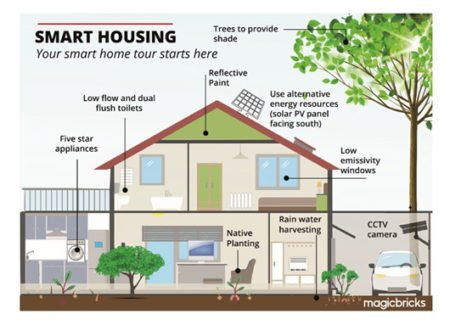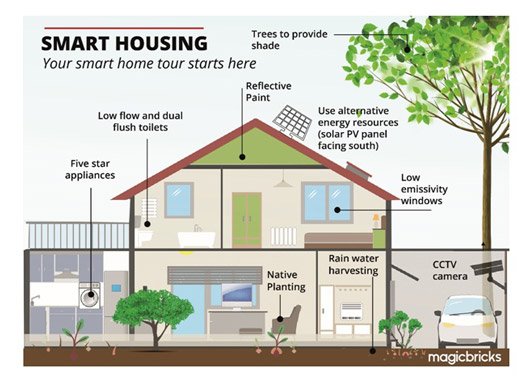
The infrastructure of a city is the key to its development. It not only improves the liveability quotient of the city, but also makes housing and working conditions comfortable. The Government is now providing a thrust to infrastructure through various initiatives which in turn will provide a larger push to the real estate sector.
Smart Cities is one such initiative that aims to make cities liveable and sustainable. Smart cities are e-driven, compact, pollution-free, industry-oriented, future ready and offer high living standards at affordable cost. India is entering the era where infrastructure will be at the core of the city’s vision and drive the way it functions. The city’s real estate is bound to respond in tandem with the upgraded infrastructure.
“The development of smart cities will create a modern infrastructure network that will encourage private enterprises to develop world-class residential and commercial real estate in the future within this environment,” says Gunjan Goel – Goel Ganga Developers, Pune.
Infrastructure – A key element of liveability
Smart infrastructure is the need of Indian cities. This includes roads with cycle tracks, 24X7 water and power, ICT enabled infrastructure, domestic waste collection, recycling of water, rainwater harvesting, waste to energy processing and more. These features are not just theoretical knowledge today but the new and evolving cities of India are working to make these a reality.
Dholera SIR (Special Investment Region), India’s first smart city, is running on smart infrastructure. Rajesh Phadke, chief architect and planner, GIFT Company Limited says, “We have earmarked 5% of the total area for parks and open green spaces. There is also space for shaded pathways and large green public activity areas. The social infrastructure including amenities for health, education, retail and other public facilities are at a walking distance of 5-10 minutes.”
Let us understand these elements in detail –
Smart housing
Smart houses are built as per the codes of the Indian Green Building Council (IGBC) guidelines. All houses in smart cities are connected with a network of fibre optic cables to provide telephone and broadband connectivity. There should be rain water harvesting to conserve water, five star appliances to save power, solar panels to use alternative sources of energy, low emissivity windows, reflective paints, native plants and more.
Smart mobility
Infrastructure also provides different means of commuting other than cars and bikes. Most of the mobility needs of a smart city should be fulfilled by walking and cycling. The public transport should be efficient and environment friendly. Last mile connectivity issues should be addressed by making bus stops within 300 metres from any point.
Transport infrastructure should be planned on priority for pedestrians, cyclists, electric vehicles and other private vehicles. For electric cars, charging points should be provided at a number of locations.
Smart sanitation
Sewage should be treated and must not be released in rivers or water bodies. The methane released from sewage should be captured and used as fuel and it’s residue can be used as a bio-fertiliser.
Water management
Water should be treated as a precious natural resource. The infrastructure should be such that water supply should be metered. Dual water supply lines should be established – one for drinking and cooking and the other for various uses. Each housing complex should have rain water harvesting and water treatment plants for optimum usage.
Technology infrastructure
Internet connectivity along with cell phone coverage is essential in smart cities as most of the city services are offered online. Multiple service kiosks have to be set up for people to access public services and information. “Technology infrastructure can provide real time vehicle tracking, control of street lighting, solid waste serving vehicle tracking, citizen’s portal, online building permissions and water and energy management applications at testing level,” says Kanchan Sidhaye, GRIHA trainer and evaluator, BEE Energy Manager, VK:e environmental, a green consulting firm based in Pune.
Solid waste management
Solid waste must be mandatorily segregated into dry and wet waste and collected through separate channels that handle all activities from collection to disposal. Where wet waste can be used by converting into fuel/fertiliser/heat source, while the dry waste should be segregated into reusable parts and non-usable parts which can further be converted into electricity.
Smart industry
Smart cities are employment oriented. They should follow guidelines given by ‘Ease of Doing Business Index’ to facilitate industrial development. They should provide ‘single window clearance’ system for industries. Fuel pipelines and dedicated high tension electricity lines should be provided for uninterrupted supply of energy.
Social infrastructure
A well-developed social infrastructure ensures better liveability for citizens as they don’t have to go far for basic amenities. This includes education facilities such as schools and colleges, good quality healthcare facilities and entertainment facilities that make people happy.
Smart security
A smart city should be covered by CCTV cameras for round-the-clock surveillance. Advanced surveillance techniques with facial recognition and video processing should be implemented to track would-be criminals.
By Preeti Sharma, Magicbricks Bureau
Smart infrastructure: The future of Indian real estate






